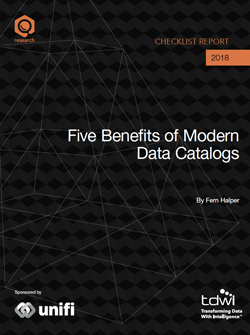
TDWI Checklist Report | Five Benefits of Modern Data Catalogs
December 7, 2018
In today’s competitive business climate, organizations thrive on the strength of their data and analytics programs. High-performing organizations often capture different kinds of data from multiple sources.
Data catalogs are one way to manage an increasingly complex data landscape. Catalogs are critical for successful analytics because they help users identify and understand what data exists and is available for analysis.
Traditional data catalogs have been used to help inventory data. These older-style data catalogs provide a data directory that describes the data. This includes metadata about data type, data source, date of creation, and other properties. However, traditional catalogs are often hard to update manually—a problem when there is a large amount of disparate data spread across multiple systems. To deal with multiple data sources and structures, modern data catalogs are often AI-enabled.
In addition to automation using AI, next-generation catalogs often contain new features such as crowdsourcing and collaboration. This TDWI Checklist describes five ways modern data catalogs drive business value.